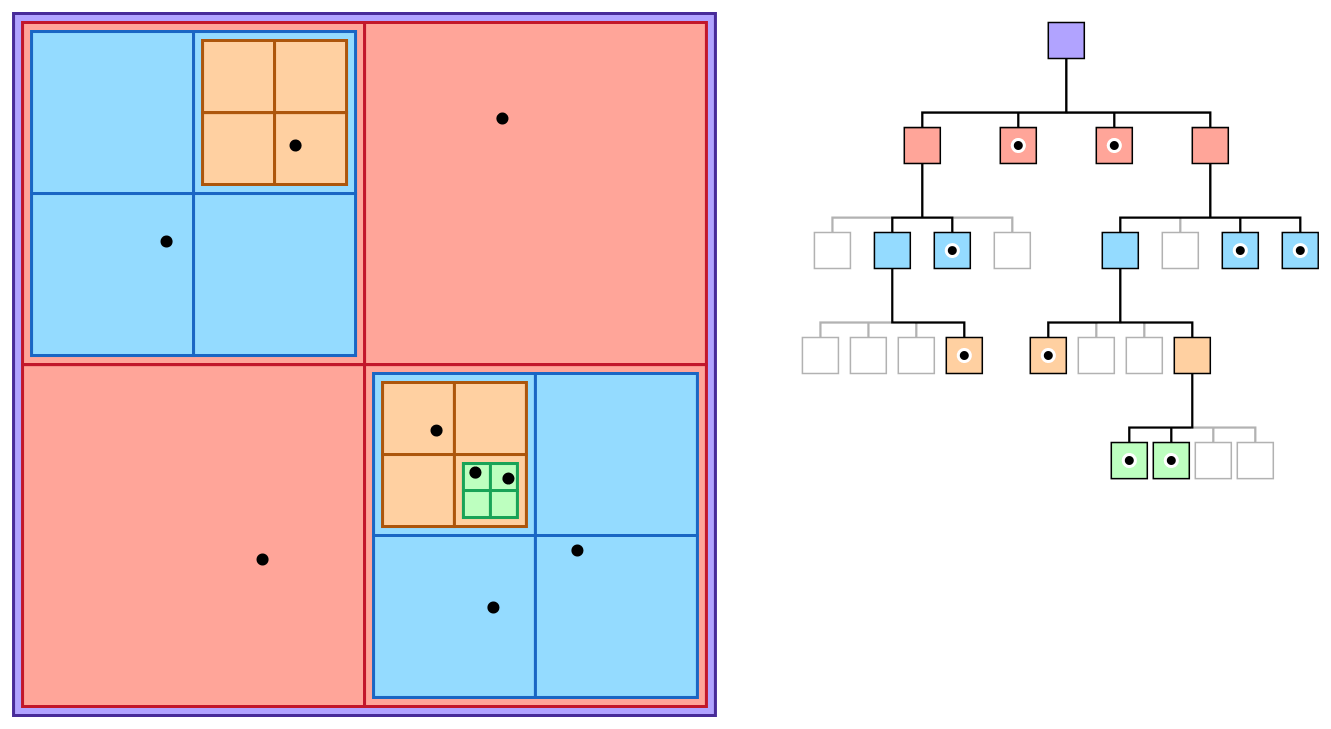http://en.wikipedia.org/wiki/Quadtree
http://blog.notdot.net/2009/11/Damn-Cool-Algorithms-Spatial-indexing-with-Quadtrees-and-Hilbert-Curves
https://developer.apple.com/documentation/gameplaykit/gkquadtree
 The quadtree partitioning strategy divides space into four quadrants at each level, as illustrated in Figure 1. When a quadrant contains more than one object, the tree subdivides that region into four smaller quadrants, adding a level to the tree.
The quadtree partitioning strategy divides space into four quadrants at each level, as illustrated in Figure 1. When a quadrant contains more than one object, the tree subdivides that region into four smaller quadrants, adding a level to the tree.
Figure 1

A quadtree is a tree data structure in which each internal node has exactly four children. Quadtrees are most often used to partition a two-dimensional space by recursively subdividing it into four quadrants or regions. The regions may be square or rectangular, or may have arbitrary shapes.
A similar partitioning is also known as a Q-tree. All forms of quadtrees share some common features:
- They decompose space into adaptable cells
- Each cell (or bucket) has a maximum capacity. When maximum capacity is reached, the bucket splits
- The tree directory follows the spatial decomposition of the quadtree.
public class QuadTree<Key extends Comparable<Key>, Value> { private Node root; // helper node data type private class Node { Key x, y; // x- and y- coordinates Node NW, NE, SE, SW; // four subtrees Value value; // associated data Node(Key x, Key y, Value value) { this.x = x; this.y = y; this.value = value; } } /*********************************************************************** * Insert (x, y) into appropriate quadrant ***************************************************************************/ public void insert(Key x, Key y, Value value) { root = insert(root, x, y, value); } private Node insert(Node h, Key x, Key y, Value value) { if (h == null) return new Node(x, y, value); //// if (eq(x, h.x) && eq(y, h.y)) h.value = value; // duplicate else if ( less(x, h.x) && less(y, h.y)) h.SW = insert(h.SW, x, y, value); else if ( less(x, h.x) && !less(y, h.y)) h.NW = insert(h.NW, x, y, value); else if (!less(x, h.x) && less(y, h.y)) h.SE = insert(h.SE, x, y, value); else if (!less(x, h.x) && !less(y, h.y)) h.NE = insert(h.NE, x, y, value); return h; } /*********************************************************************** * Range search. ***************************************************************************/ public void query2D(Interval2D<Key> rect) { query2D(root, rect); } private void query2D(Node h, Interval2D<Key> rect) { if (h == null) return; Key xmin = rect.intervalX.low; Key ymin = rect.intervalY.low; Key xmax = rect.intervalX.high; Key ymax = rect.intervalY.high; if (rect.contains(h.x, h.y)) StdOut.println(" (" + h.x + ", " + h.y + ") " + h.value); if ( less(xmin, h.x) && less(ymin, h.y)) query2D(h.SW, rect); if ( less(xmin, h.x) && !less(ymax, h.y)) query2D(h.NW, rect); if (!less(xmax, h.x) && less(ymin, h.y)) query2D(h.SE, rect); if (!less(xmax, h.x) && !less(ymax, h.y)) query2D(h.NE, rect); } /*************************************************************************** * helper comparison functions ***************************************************************************/ private boolean less(Key k1, Key k2) { return k1.compareTo(k2) < 0; } private boolean eq (Key k1, Key k2) { return k1.compareTo(k2) == 0; } }http://gamedevelopment.tutsplus.com/tutorials/quick-tip-use-quadtrees-to-detect-likely-collisions-in-2d-space--gamedev-374
public class Quadtree { private int MAX_OBJECTS = 10; private int MAX_LEVELS = 5; private int level; private List objects; private Rectangle bounds; private Quadtree[] nodes; /* * Constructor */ public Quadtree(int pLevel, Rectangle pBounds) { level = pLevel; objects = new ArrayList(); bounds = pBounds; nodes = new Quadtree[4]; }}/* * Splits the node into 4 subnodes */ private void split() { int subWidth = (int)(bounds.getWidth() / 2); int subHeight = (int)(bounds.getHeight() / 2); int x = (int)bounds.getX(); int y = (int)bounds.getY(); nodes[0] = new Quadtree(level+1, new Rectangle(x + subWidth, y, subWidth, subHeight)); nodes[1] = new Quadtree(level+1, new Rectangle(x, y, subWidth, subHeight)); nodes[2] = new Quadtree(level+1, new Rectangle(x, y + subHeight, subWidth, subHeight)); nodes[3] = new Quadtree(level+1, new Rectangle(x + subWidth, y + subHeight, subWidth, subHeight)); } public void insert(Rectangle pRect) { if (nodes[0] != null) { int index = getIndex(pRect); if (index != -1) { nodes[index].insert(pRect); return; } } objects.add(pRect); if (objects.size() > MAX_OBJECTS && level < MAX_LEVELS) { if (nodes[0] == null) { split(); } int i = 0; while (i < objects.size()) { int index = getIndex(objects.get(i)); if (index != -1) { nodes[index].insert(objects.remove(i)); } else { i++; } } } }http://blog.notdot.net/2009/11/Damn-Cool-Algorithms-Spatial-indexing-with-Quadtrees-and-Hilbert-Curves
https://developer.apple.com/documentation/gameplaykit/gkquadtree
Spatial and logical arrangement of an example quadtree
